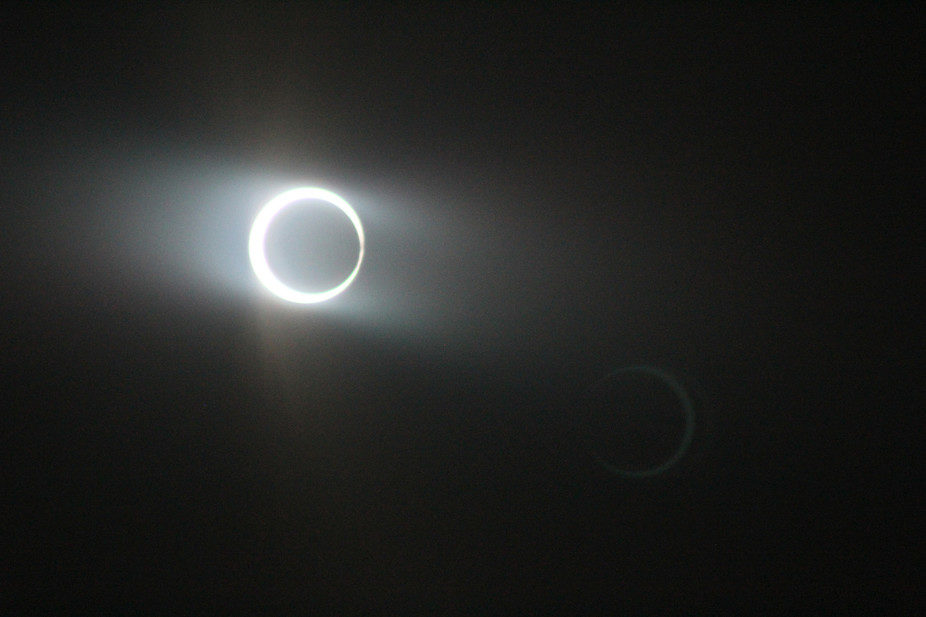
© Grand Canyon National ParkA solar eclipse observed over Grand Canyon National Park in May 2012.
On Monday,
Aug. 21, people living in the continental United States will be able to see a total solar eclipse.
Humans have been alternatively
amused, puzzled, bewildered and sometimes even terrified at the sight of this celestial phenomenon. A range of social and cultural reactions
accompanies the observation of an eclipse. In ancient Mesopotamia (roughly modern Iraq), eclipses were in fact regarded as omens, as signs of things to come.
Solar and lunar eclipses For an eclipse to take place, three celestial bodies must find themselves in a straight line within their elliptic orbits. This is called a syzygy, from the Greek word "súzugos," meaning yoked or paired.
From our viewpoint on Earth, there are two kinds of eclipses: solar and lunar. In a solar eclipse, the moon passes in between the sun and Earth, which results in blocking our view of the sun. In a lunar eclipse, it is the moon that crosses through the shadow of the Earth. A solar eclipse can completely block our view of the sun, but it is usually a brief event and can be observed only in certain areas of the Earth's surface; what can be viewed as a total eclipse in one's hometown may just be a partial eclipse a few hundred miles away.
By contrast, a lunar eclipse can be viewed throughout an entire hemisphere of the Earth: the half of the surface of the planet that happens to be on the night side at the time.
Eclipses as omens More than two thousand years ago, the Babylonians were able to calculate that there were 38 possible eclipses or syzygys within a period of 223 months: that is, about 18 years. This period of 223 months is called a Saros cycle by modern astronomers, and a sequence of eclipses separated by a Saros cycle constitutes a Saros series.
Although scientists now know that the number of lunar and solar eclipses is not exactly the same in every Saros series, one cannot underplay the achievement of Babylonian scholars in understanding this astronomical phenomenon. Their realization of this cycle eventually allowed them to predict the occurrence of an eclipse.
The level of astronomical knowledge achieved in ancient Babylonia (southern Mesopotamia) cannot be separated from the astrological tradition that regarded eclipses as omens: Astronomy and astrology were then two sides of the same coin.
Rituals to preempt royal fate According to Babylonian scholars, eclipses could foretell the death of the king. The conditions for an omen to be considered as such were not simple. For instance, according to a famous astronomical work known by its initial words, "
Enūma Anu Enlil" - "When (the gods) Anu and Enlil" - if Jupiter was visible during the eclipse, the king was safe. Lunar eclipses seem to have been of particular concern for the well-being and
survival of the king.
In order to preempt the monarch's fate, a mechanism was devised: the "
substitute king ritual," or "šar pūhi." There are over 30 mentions of this ritual in various letters from
Assyria (northern Mesopotamia), dating to the first millennium B.C. Earlier references to a similar
late chronicle, a king of the city of Isin (modern Išān Bahrīyāt, about 125 miles to the southeast of Baghdad), Erra-imitti, was replaced by a gardener called Enlil-bani as part of a substitute king ritual. Luckily for this gardener, the real king died while eating hot soup, so the gardener remained on the throne and became king for good.
The fact is that these two kings, Erra-imitti and Enlil-bani, did exist and reigned successively in Isin during the 19th century B.C. The story, however, as told in the late "Chronicle of Early Kings," bears all the trademarks of a legend. The story was probably devised to explain a dynastic switch, in which the royal office passed from one family or lineage to another, instead of following the usual father-son line of succession.
Mesopotamia was not unique in this regard. For instance, a chronicle of early China known as the "Bamboo Annals" (竹書紀年 Zhúshū Jìnián) refers to a total lunar eclipse that took place in
1059 B.C., during the reign of the last king of the Shang dynasty. This eclipse was regarded as a sign by a vassal king, Wen of the Zhou dynasty, to challenge his Shang overlord.
In the later
account contained in the "Bamboo Annals," an eclipse would have triggered the political and military events that marked the transition from the Shang to the Zhou dynasty in ancient China. As in the case of the Babylonian "Chronicle of Early Kings," the "Bamboo Annals" are a history of earlier periods compiled at a later time. The "
Bamboo Annals" were allegedly found in a tomb about A.D. 280, but they purport to date to the reign of the King Xiang of Wei, who died in 296 B.C.
The complexity of human events is rarely constrained and determined by one single factor. Nevertheless, whether in ancient Mesopotamia or in early China, eclipses and other omens provided contemporary justifications, or after-the-fact explanations, for an entangled set of variables that decided a specific course of history.
Even if they mix astronomy and astrology, or history with legend, humans have been preoccupied with the inescapable anomaly embodied by an eclipse for as long as they have looked at the sky.
[Link]
[Link]
Rick Levine
[Link]